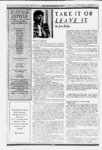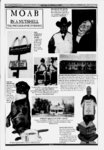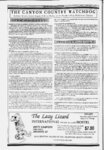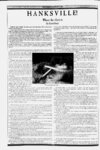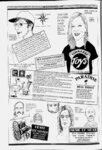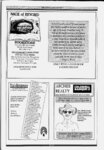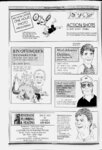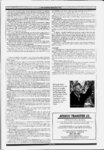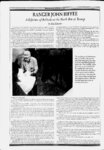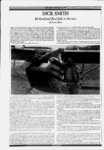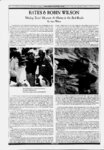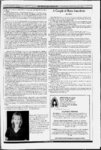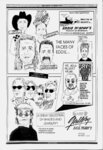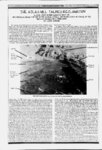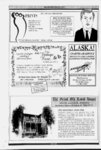| OCR Text |
Show M,i,.V,.WiVAVAWAW,.,.S,.WV.VVj,AV.ft,.V.,.VAAV.,AW. ... SV.V.V. V.'.V.V. .. V..' V.V. w. .v.v.v.,.v.v.'.v.v.v.v.v.v.v.v.v . . u S . J. S A i1 ::. $3 i v. & y. '. i 4) DICK SMITH I marl ft J-I- o A year or so ago Jim Stiles came by fora visit and in the course of the conversation we talked about Indian ruins and how they were being vandalized. Yk wondered if, at the present rate ofvanddism, there would be any pristine ruins left for archaeologists to study in the future. I mentioned that I had seen a few such ruins in the past. One had been viewed from a helicopter when I was flying with a wildlife biologist from the Division of Wildlife Resources. I viewed another large diff ruin from a smell plane as I flew in a remote area of Canyordands National Park. I had been flying with a friend of mine by the name of Dick Smith. Jim asked if someday I would write an article about Did for the Zephyr. I have thought about this article for sane time now and Fm really not sure how to approach it. I hadn't known Dick for too many years before his death, but I had known him long enough to fed a friendship and to also feel akin to sane of the deep fodings he had for what he liked to call his canyordands". This is my story of Did, both as a friend, and as a person. of the plane taking pictures. Dr. Matheny replied, "That will be Larry's job." I had heard about Dick long before I met him. Dr. Ray T. Matheny, a professor of anthropology at Brigham Young University, had told me stories of flying with Dick in southeastern Utah. Dr. Matheny and Dick shared a love of flying and they had flown over the Four Comers area a number of times. Dick Smith was bom in Monticello, Utah. It seemed that he had always loved and enjoyed the outdoors. As a young man he learned to hunt and trap and live off of the land. He worked as a truck driver, cat skinner, deputy sheriff, crop duster, pilot and resort manager, hie even tried college for a while, but flying was his first love, followed closely by his passion for the canyon country of southern Utah. He was an ambitious person who seemed to love life and he crammed as much life as possible into each day. In 1968, during my senior year at the University, I was one of two students chosen to go to the Yucatan Peninsula in Mexico to conduct some archaeological research. Dr. Matheny informed us that we were going to fly down in a small private plane piloted by Dick Smith. After hearing stories about him from Dr. Matheny, I was excited to go. The trip was one that I will long remember. Dick picked us up in Provo in early April. We were to fly from Provo to Monticello where Dick was to say his goodbyes to his family. On the way to Monticello from Provo, Dick informed us that he wanted to show us some Indian ruins. We were in the Canyordands area at the time and had seen a few small storage granaries tucked in small stone constructed overhangs. He wanted to show us a tower. The tower was of course-lai-d I Dick where some asked Anasazi hundred the or nine eight people probably by years ago. flew be we be it. would above when we as a us that would with He it it replied, past grin, first saw it We were flying down the Green River, and, as we rounded a bend in the river, sure enough, the tower was directly in front of and above us. Dick pulled back on the controls and we flew right over the tower. We had a very close view of the ruin. to town, Dick had been out shopping and bartering with locals. He enjoyed his time there and I am sure the natives enjoyed being with this mountain of a man as welL As I mentioned, the trip down was uneventful The return flight was just the opposite. We spent our first night in a Texas town just over the border. We left early the next morning and planned to fly at least as far as Farmington, New Mexico. The following day s trip would then be just a short one to Monticello and on to Provo. It was nearing late afternoon when we passed Albuquerque, New Mexico and headed for Farmington. We had been flying for a while when it started to snow, lightly in the beginning and then much heavier. It got bad enough that Dick turned back toward Albuquerque. But now it was snowing even harder and we were flying right on the deck. I remember passing over Navajo hogans and seeing the people come out and watch us fly right past them. Dick was looking for a good place to land. By this time Dick knew we could never make it all the way back to Albuquerque. He had turned and headed us back toward Farmington. We knew we were dose but we couldn't see much of anything. Dick found a dirt road and decided to land and sit out the storm. We made one approach to see if the road appeared good enough to land on. We made a very good landing. Dick always seemed to be calm and in control of the situation. When we taxied to a stop, Dick told us the landing had been a bit touchy because one of the brakes locked up as we touched down. But he handled the situation without a hint of outward emotion of excitement After we had come to a stop I mentioned that I was shaking and attributed it to being cold. Dr. Matheny indicated that I wasn't cold, I was scared. Looking back on the situation, he was probably right. It is not every day that you land a small plane on a muddy dirt road in a snow storm. Yeah, I guess I was scared. Our flight to Mexico was uneventful. We flew to Campache, Mexico, and did some archaeological field work while we were there. Prior to our leaving on the trip, Dr. Matheny had mentioned to the students that we were also going to take aerial photographs of some of the ruins on the Yucatan Peninsula while we were there. He explained that we would be flying in a small plane and, in order to take the pictures with a hand held camera, we would take one of the doors off and someone would have to hang partially out of the plane and take the pictures as we flew in a grid pattern at a set altitude. This sounded quite exciting to me until one of the students asked who would be hanging out 5 w PPWPB When the time came to take pictures, we removed the door. They tied a nylon rope to my waist (a big nylon rope), and then Dr. Matheny got a good grip on my belt and the waist of my pants. He would tap me on the shoulder at intervals and I would take the picture. While Dick flew the grid pattern at a set speed, I partially hung out of the plane and took pictures. Dick held the plane as steady as possible. To get a feeling for this mph in a car with the upper half of your body handing out of the experience, go to the stoiy is that after we returned to the States and window (Ait interesting side-ligdeveloped the film we discovered that the camera had malfunctioned and none of the pictures turned out). Dick couldn't speak a word of Spanish. That didn't seem to slow him down. While 90-1- 00 ht we were out in the field, Dick stayed in the city and toured the area. When we came back Beginning in the summer of 1963 and continuing for a number of summers when I was in school, I worked as a boatman on the Yampa, Green, and Colorado rivers. In the Spring of 1970 1 was approached by Dr. Matheny and asked if I would be willing to act as one of the boatmen for a trip through Cataract Canyon. I jumped at the chance. The trip was sponsored by the National Park Service its purpose to show the Canyonlands National Park advisory council a portion of Canyonlands firsthand. I was to be paid by the National Perk Service and would be working for them while I was on the river. The group split up and one group started just south of Moab. The iTWENXY'FjOUR t. J |

